I’ve heard a lot about Meopta Optics, but I had yet to get first-hand experience with one… until now. Meopta had a lot to live up to based on what I’ve been told, and the Optika6 4.5-27×50 fills the shoes that have been laid out. This optic is feature-packed; from locking turrets and a lighted reticle to a detachable magnification ring lever. It also boasts high optical clarity on a 6x zoom range and a high level of precision.
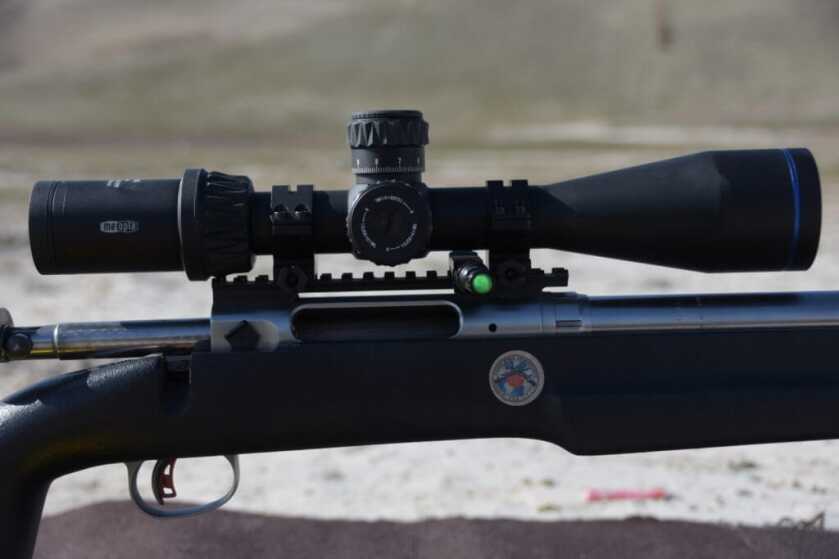
Interesting Features of The Optika6
As mentioned, the Optika 6 boasts a ton of features that are typically found in “higher end” (more expensive) optics. I’ll start at the ocular lens and work my way forward: the first unique feature is the detachable magnification ring lever. This lever makes rapid magnification adjustments quick and easy. It can be screwed into any of 4 different mounting locations, according to your preference. That said, the magnification ring is rubberized and easy to grip, so in the end, I chose to leave the throw-lever off.

Moving forward, we get to the turrets. This particular aspect of the optic was especially great! Clicks were extremely crisp and audible. They had no slop or mush in their operation. On top of that, the elevation turret has a zero-stop that is easy to set as well as a locking function. To unlock the elevation turret to make adjustments, simply pull up on the knob and it snaps into place. Then you can make the adjustment and push the knob back down to lock, where it will again snap into place with a loud click.
The parallax adjustment is opposite of the windage turret, and also contains the illumination dial. Adjusting the parallax is smooth and appeared to be accurately marked in yardages. The illumination dial is located further out on the knob and has 6 brightness settings with an off in-between each. It is powered by a CR2032 battery held under a waterproof cap that can be unscrewed using a coin or other tool. The optic that I received had an MRAD-1 reticle. In this model, just the center of the crosshair is illuminated.
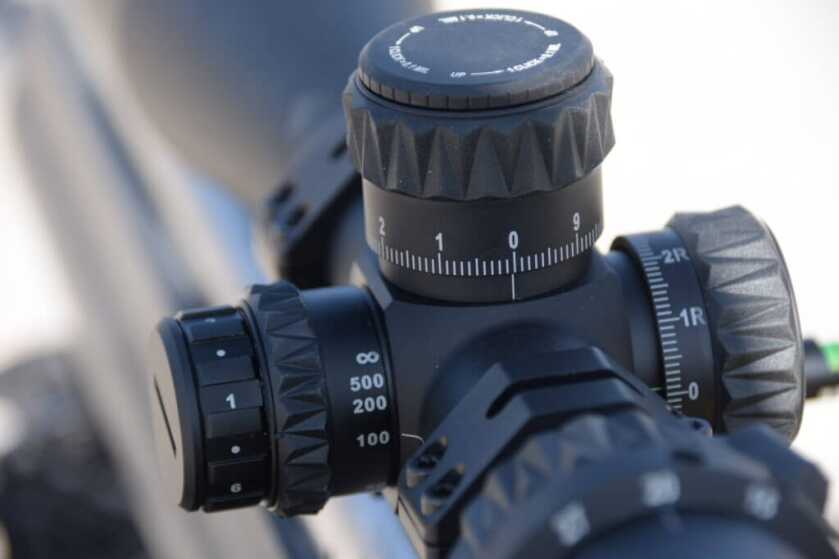
These scopes come in either MOA or MIL models. The MOA models are offered in both First Focal Plane (FFP) and Second Focal Plane (SFP) while the MIL models are only offered in FFP. You also get your pick from 8 different reticles, so you are sure to find one that you like.
Setting The Zero Stop Mechanism
I will say, setting the zero stop using the instructions that are supplied in the manual is not as intuitive as whoever wrote the manual thought it was. Because of this, I’ll tell you how to do it in my own words. First, you must loosen the cap on the elevation turret while it is in its locked position. Then you lift the turret to the unlocked position and remove the turret. This exposes the zero stop mechanism. Next, you will need to loosen the 3 Allen screws located radially on the steel collar. Only loosen them about 1/4 – 1/2 turn; any more is unnecessary. Once these set screws are loosened, you can rotate this collar around to butt against the stop. You must rotate the collar in the clockwise direction to this point.
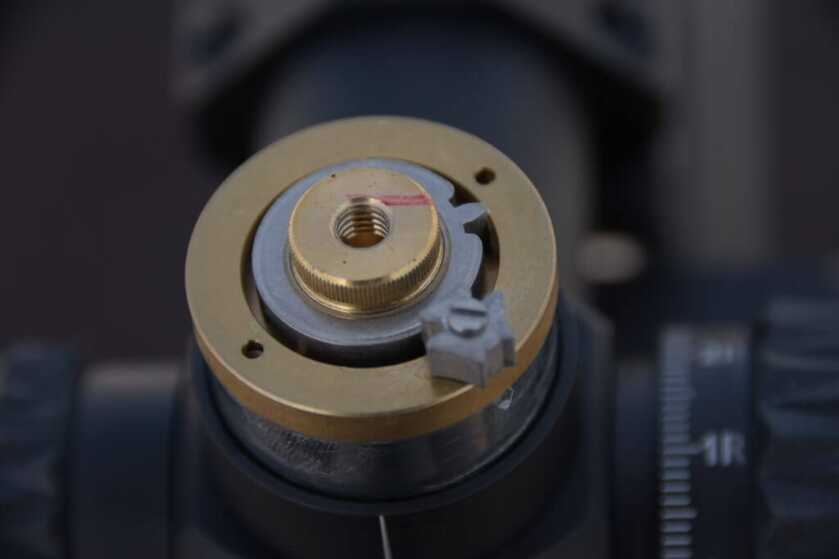
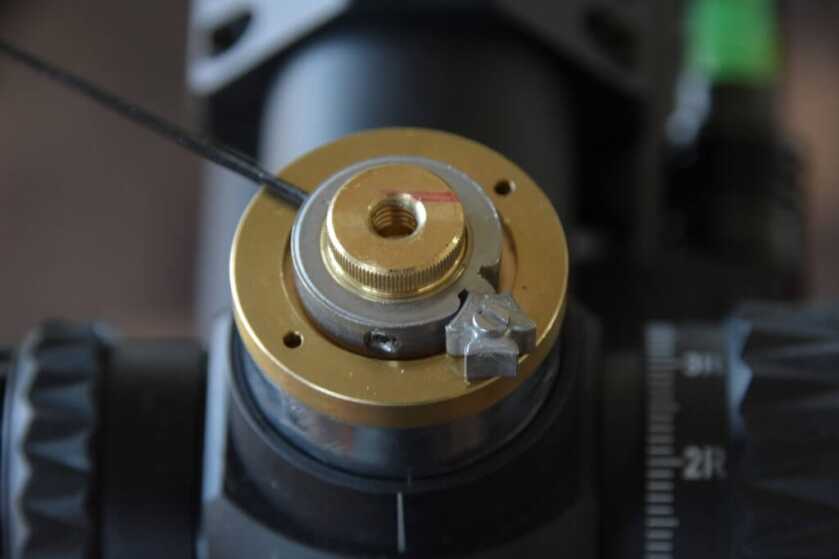
Once you have arrived at this point, you are almost done. Take care to position the stop exactly as you see in the picture above. The stop must be oriented in this fashion because the stop is designed to rotate 2 times, giving you 3 full revolutions to work with above the zero stop. If it is oriented incorrectly, the stop will be located 1 to 2 rotations below what you meant to set, and your elevation will be limited. If you have this correct, put everything back together with the turret indicating zero and you are ready to start shooting.
Performance in The Field
Since I just covered it, we’ll address it first: The zero stop on the Optika6 4.5-27×50 is incredible. The stop is extremely positive with no play below zero, just as I like them. For an $849.99 scope, this feature gets 5 thumbs up out of 3.
While using the Optika6, I enjoyed dialing the turrets. They are extremely crisp and positive. When you crank the turret around rapidly, it still feels like a ratchet, not a pepper grinder. Again, when compared to other scopes in this $800-$1,000 price range, this scope comes out on top. The other feature that I really enjoyed was the locking elevation turret. I wish the windage turret shared this function, but sadly, it does not. Even so, the unlocking and locking of this turret created an audible click that was not only satisfying but useful. Thanks to this audible indication, I knew when the turret was ready to be operated.

The other thing that you are sure to ask is hard to explain/show in a written review, but I will do my best… The optical clarity of the Optika6 is phenomenal. Even though I would not describe it as being the best glass I have used, it is also not the most expensive optic I have used. Again, in this area, the Optika6 is best described as being much better than other offerings in its price range. The light transmission is great, bringing a bright image to the eye long after and before many other optics can during sunset and sunrise. The edge-to-edge clarity is also fantastic, having no noticeable difference in clarity from center to edge. Meopta Optics lives up to its reputation again.
With many different reticles available, I found a reticle that I really liked. On this riflescope, I went with the MRAD-1 option and quickly grew fond of it. The field of view is very open thanks to this reticle that lacks a vertical crosshair to split the 1st and 2nd quadrant of the optic. I also enjoyed using the dropdown reticle because the points of reference are very fine and precise. I was able to spot my impacts through them as well as make corrections based on them.

Turret Tracking Accuracy
As with all of my rifle optics tests, I checked the most important aspect of the Optika6 (in my opinion) using a tall target test in order to determine the scope’s tracking accuracy. The first step in this test is to mount the optic on the gun using a bubble level and plumb bob. This has to correlate to a rifle mounted bubble level which will be used in the field to level the optic. Next, I take a gridded target (with 1-inch squares in my case). This helps me level the target while in the field for the test. It is important to use a precise rifle for this test to minimize any kind of error. For this purpose, I used my Savage target rifle with criterion barrel chambered in 308 Winchester. For ammunition, I used factory Buffalo Bore Sniper 175 grain HPBT ammunition.
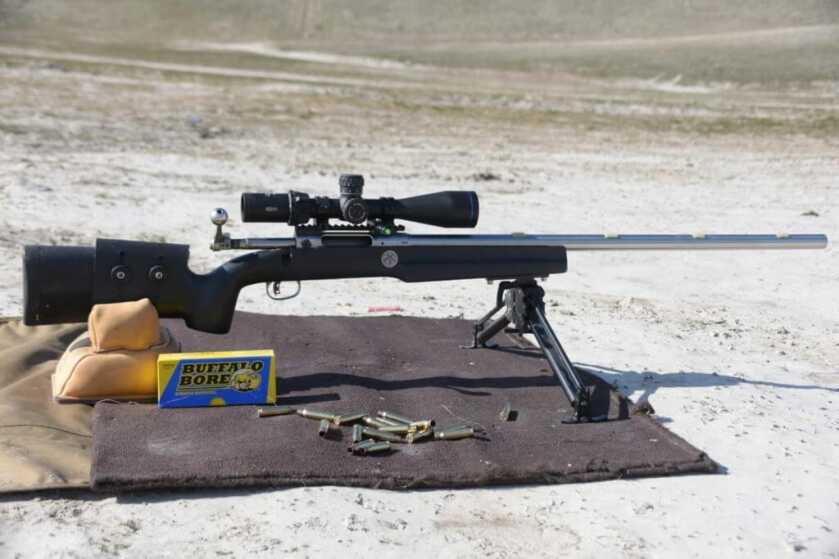
Next, I set up my shooting position about 100 yards away and then laser rangefind the distance with multiple rangefinders to confirm the range. For this purpose, I use a Leupold RX2800 TBR/W and confirm with a Leica 1600 B. I determined the distance to be 98.3 yards using this method. This distance will then be used later in my math to determine the tracking accuracy of the optic.
From here, I shoot. In this test, I fired 3 rounds at my point of aim at the bottom center of the target. Next, I dialed up 10 Mils exactly on the turret and fired a 3 shot group while aiming at my original point of aim, all while keeping the gun level. Immediately after, I dialed back down 10 Mils and fired a 3 shot group in a similar fashion. The distance between these two groups will be used to check the tracking accuracy of the elevation turret of the Optika6. Any deviation from my vertical line will also be noted in the test.
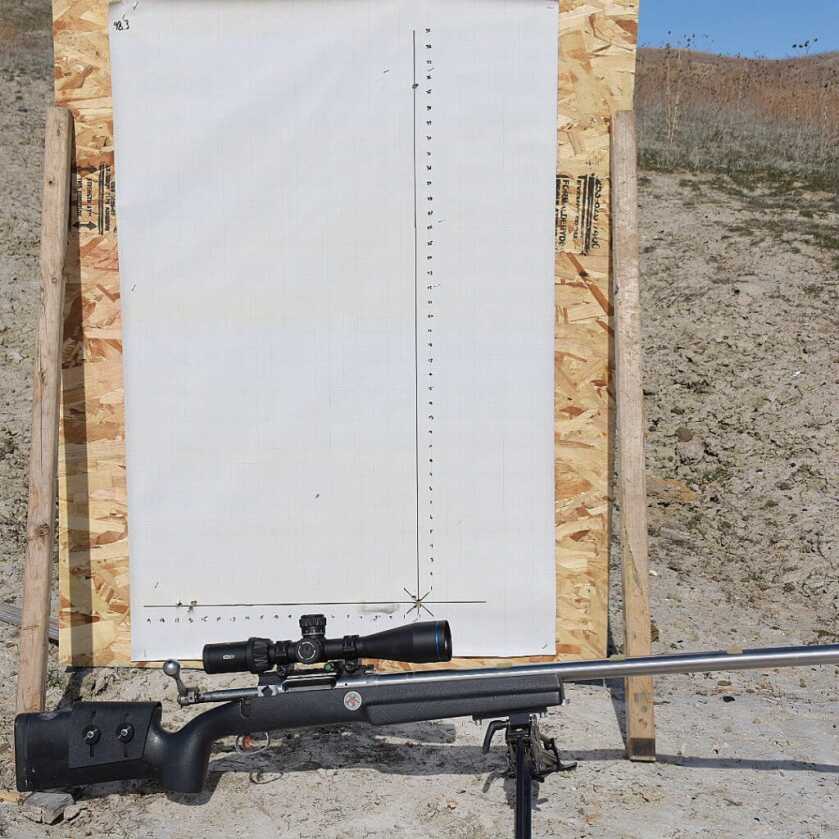
The formula I use to draw my conclusions from this test is as follows:
***Distance from target x MRAD value dialed x MRAD to inches conversion factor = expected point of impact in inches***
After measuring the distance between the reference group and test group on the X and Y axis, I found the distances to be 15.81” and 35.5” respectively. Using the equation, I found that I should expect the elevation’s distance of travel at 98.3 yards (confirmed with 2 different rangefinders) to be 35.388” which means that the elevation turret tracked with 99.7% accuracy in my test! Given the number of variables that I cannot control, this is outstanding performance shown by the Optika6.
***98.3 yards x 10 mil x 0.036 inches/mil*yard = 35.388 inches***
Using the same equation, I calculated the expected distance between the reference group and test group on the X-axis to be 15.924”. Given that the experimental distance is 15.8125”, this means that the windage turret tracked with 99.3% accuracy in my test. Again, another impressive result from the Optika6.
***98.3 yards x 4.5 mil x 0.036 inches/mil*yard = 16.1568 inches***
Final Verdict
After using the Optika6 for a few months, I have grown fond of it. I’ve reviewed a handful of mediocre optics as well as incredible ones. I’d categorize the Optika6 4.5-27×50 under the incredible offerings. This optic is feature-packed, extremely affordable for what you are getting, the optical quality is fantastic and you get a great warranty from a well-established company that will be here for years to come.
Even after putting this optic through the toughest tracking test, I remain impressed with its capabilities. I would be comfortable assuring anybody who is interested in buying one that this is a good purchase.

Specifications
- 4.5-27x magnification
- 50mm objective lens
- 30mm tube diameter
- exit pupil: 9.5 – 1.9 mm diameter
- 3.94″ eye relief
- 21.9 – 3.6 ft/100yd field of view
- 91% daylight transmission
- 88% twilight transmission
- 1/10th MIL or 1/4 MOA per click
- 84 MOA windage and elevation adjustment
- 31.1 oz
- 14.21″ long
- MSRP $599.99 – $949.99 depending on model (this specific scope is $849.99)
Find out more about Meopta Optics HERE!
Additional Pictures:
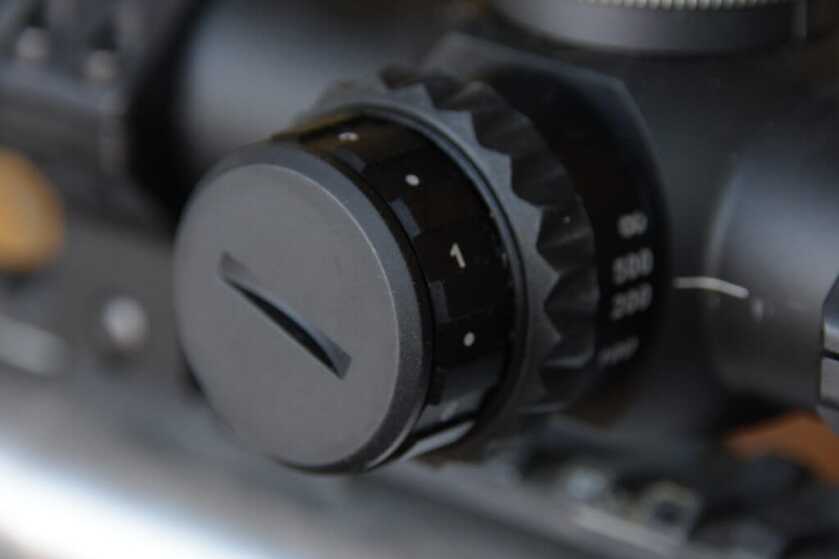
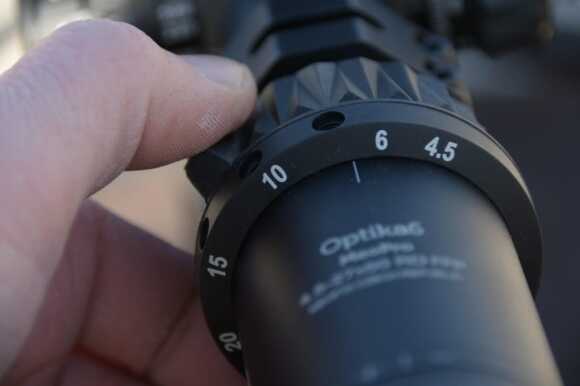



Riley, you mentioned in your article about the Meopta Optika6 4.5-27×50 that you had tested several outstanding optics and several mediocre optics. I scrolled back to review your recent optics evaluations and did not see other articles, looking for a quick summary. Do you have a summary of the good optics you have evaluated and the not so good optics? Or at least a way to locate your articles?
Thank you,
Ken
2nd that request!!
Great review, very nice scope and detailed descriptions were great too, enjoy the article.
For a scope I can only dream about 😩